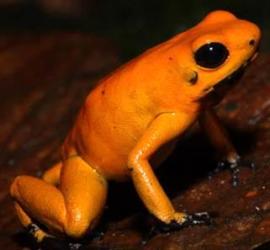 |
| Golden Poison Frog |
(Washington, D.C., May 8, 2012) Conservationists are celebrating the establishment of a new nature reserve in Colombia that provides the first sanctuary for the endangered golden poison frog, an animal that also has the distinction of being possibly the world’s deadliest animal. Its poison is so toxic that even coming in contact with a paper towel that has touched the frog has been fatal to animals. Although they are only two inches long, it is estimated that each golden poison frog has enough toxin to kill ten adult people within minutes.
In one of the wettest tropical rainforests in the world, along the Pacific coast of western Colombia, World Land Trust, American Bird Conservancy, and Global Wildlife Conservation have helped purchase 124 acres of threatened Chocó forest, creating the Rana Terribilis Amphibian Reserve named for the Spanish word for frog – rana – and the frog’s Latin name Phyllobates terribilis. The reserve is owned and managed by Fundación ProAves, Colombia’s leading conservation organization. This is the second amphibian reserve owned by ProAves in Colombia – the first is the Ranita Dorada Reserve.
This frog is named because of its bright orange skin that is covered by a secretion of deadly alkaloid poison (batrachotoxins). The toxin prevents nerves from transmitting impulses, leaving muscles in a constant state of contraction – leading to heart failure. Death comes within minutes.
The species has long been recognized by indigenous cultures for its lethal poison and is strongly embedded within cultural traditions. The Chocó Emberá Indians use the frog’s toxin as poison in their darts used to hunt food; by gently brushing the tips of arrows and darts on the frogs back, without harming it, the weapons can keep their deadly effect for over two years.
The frog’s poison is entirely for self-defense, yet it does little to help its chances of survival against its single biggest threat – bulldozers. Habitat damage and destruction continues to escalate due to illegal gold-mining (an estimated 100 bulldozers and excavators are destroying the area), and illegal logging.
Despite this frog’s infamous reputation and its importance to indigenous cultures, it is considered by many to be on the edge of extinction, and until now the species was completely unprotected. Dependent on primary forest, the golden poison frog occurs patchily across an area less than the size of the tiny Caribbean island of Barbados. Due to its restricted range and low population, the frog was added to the list of some of the world’s most imperiled creatures identified by the Alliance for Zero Extinction.
Notably, the reserve will also afford protection for several key bird species, including the endangered Baudó Guan, a medium-sized game fowl whose worldwide population is estimated at 10,000-20,000 individuals; the vulnerable Brown Wood-Rail, a medium-sized, mostly rufous-brown rail whose population is estimated to be between only 1,000 and 2,500 individuals; and the vulnerable Great Curassow, a large, pheasant-like bird whose population is estimated to be between 10,000 and 60,000 individuals.
“The support from our partners made the creation of this critical new reserve possible, and one of the world’s most amazing creatures, the beautiful and deadly golden poison frog, is now protected.” said Lina Daza, Executive Director of Fundación ProAves.
“That this effort is helping to save even a portion of a rainforest is significant, and we’re glad we have been a part of it. We need to halt the continued, rapid disappearance of rainforests and the resultant loss of wildlife that depend on them,” said Dr. George Fenwick, President of American Bird Conservancy.
Acclaimed journalist Simon Barnes, a WLT council member, wrote in The Times of London newspaper in September 2011: “Astonishing: we are on the edge of wiping out one of the most extraordinary and thrilling creatures on the planet. No matter how well a creature is protected by nature and by evolution, it is always vulnerable to humans. There’s nothing we can’t do when we put our minds to it. Still, at least we are now beginning to put our minds to saving the golden poison frog: we would all be much poorer without such a creature to give us nightmares.”
The new reserve is also the initiation of an ambitious project called the Chocó Corridor that will connect many highly threatened habitats, from the mangroves on the Pacific Coast to cloud forests on the highest peaks of the western Andes. The Golden Poison Frog Reserve and Choco Corridor is supported by Conservation International, the International Union for the Conservation of Nature, the Beneficia Foundation, and private donors.
American Bird Conservancy (ABC) is a 501(c)(3) not-for-profit membership organization whose mission is to conserve native birds and their habitats throughout the Americas. ABC acts by safeguarding the rarest species, conserving and restoring habitats, and reducing threats, while building capacity in the bird conservation movement.
ProAves is a Colombian NGO dedicated to the conservation of birds and their habitats through research, outreach and direct conservation actions in collaboration with local communities.
The World Land Trust is an international conservation organization that takes direct action to save rainforest and other wildlife habitats. WLT and its overseas project partners have been instrumental in the purchase and protection of over two million acres, now protected as permanent wildlife reserves. WLT-US is a 501(c)(3) not-for-profit organization that is consistently awarded the highest rating by the independent group, Charity Navigator.
Global Wildlife Conservation improves life on Earth by advancing both academic and applied approaches to conservation research, action, and education. Along with its numerous strategic worldwide partners, GWC is pursuing a common goal: to save plants and animals from extinction and better understand and maintain the natural world and its biological diversity.
 |
